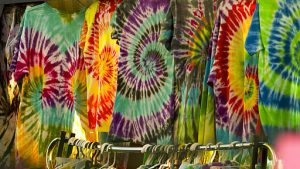
Tie-dye is the unofficial uniform of the Golden Age of Rock. It wasn’t new in the ’60s but quickly became an artistic form of protest. The establishment dress in the 50s was suit and tie for men, with dresses or skirts for women. Hair was neat, cut close for men, and conservative cuts for women. Everything was orderly and symmetric. It was a great target for rebellion, and tie-dye with its bright colors and randomness was how to do it.
Tie-dye wasn’t new; it’s just a modern term for an old process. Archeologists have found remnants of tie-dye material dating back well over a thousand years. Finds have been reported in China, Japan, India, and all of the way to Peru. The earliest date back as far as the year 500 in Peru and 600 in Japan and China. With this much geographic diversity, it was probably in use long before these finds.
Rit Dye and Tie-Dyeing
Most clothing in the 60s was store-bought, and sales at the Rit Dye company were going down. Previously, Rit was a department store staple. Don Price at Rit came up with the idea of liquid dyes that were easier to use artistically. He promoted the new dyes to artists in Greenwich Village and promoted several of them to bring their works to Woodstock.

There are lots of special techniques used to produce colorful patterns. All involve letting the dyes reach some of the cloth and blocking it from others. As the name implies, simply tying the cloth in knots forms basic patterns. Dye reaches the exposed parts but not the part inside the knot. Different types of knots or bunching the fabric produces different patterns. Stripes come from vertical folds, circles come from a single bunch, and marble comes from wrapping the entire garment in one big ball. Swirls and geometrics come from making a bunch within a bunch.
It was a combination of the growing protest movement in the late 60s along with a growing Indian influence that drove tie dye’s popularity. Once started, the Rit Dye company pushed it along with a marketing campaign in Greenwich Village and recruited decorators Will and Eileen Richardson. Their dyed fabric ideas were picked up by the designer house Halston, and the Richardsons were honored with a Coty Award for”major creativity in fabrics.”
Janis Joplin appeared at Woodstock in a Tie-dyed dress. Joe Cocker and Mama Cass wore tie-dyed clothes also. John Sebastian was tie-dyeing his underwear. By 1970, mainstream magazine Vogue featured model Maria Benson in a Halston kaftan. And counterculture band Grateful Dead picked it up as their official uniform.